Cosmology and Religion
The ancient Maya believed in recurring cycles of creation and destruction and thought in terms of eras lasting about 5,200 modern years. The current cycle is believed by the Maya to have begun in either 3114 B.C. or 3113 B.C. of our calendar, and is expected to end in either A.D. 2011 or 2012.
Maya cosmology is not easy to reconstruct from our current knowledge of their civilization. It seems apparent, however, that the Maya believed Earth to be flat and four-cornered. Each corner was located at a cardinal point and had a colour value: red for east, white for north, black for west, and yellow for south. At the centre was the colour green.
Some Maya also believed that the sky was multi-layered and that it was supported at the corners by four gods of immense physical strength called Bacabs". Other Maya believed that the sky was supported by four trees of different colours and species, with the green ceiba, or silk-cotton tree, at the centre.
Earth in its flat form was thought by the Maya to be the back of a giant crocodile, resting in a pool of water lilies. The crocodile's counterpart in the sky was a double-headed serpent - a concept probably based on the fact that the Maya word for "sky" is similar to the word for "snake". In hieroglyphics, the body of the sky-serpent is marked not only with its own sign of crossed bands, but also those of the Sun, the Moon, Venus and other celestial bodies.
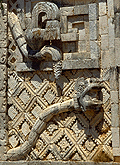 The image of the human face emerging from the jaws of the serpent is a recurrent theme in Maya art. In this case, however, the sculpture of the feathered serpent is a later (Toltec) addition to the Maya geometric mosaic design - part of an elaborate frieze on the West facade of the "Nunnery" at Uxmal
The image of the human face emerging from the jaws of the serpent is a recurrent theme in Maya art. In this case, however, the sculpture of the feathered serpent is a later (Toltec) addition to the Maya geometric mosaic design - part of an elaborate frieze on the West facade of the "Nunnery" at Uxmal
Heaven was believed to have 13 layers, and each layer had its own god. Uppermost was the muan bird, a kind of screech-owl. The Underworld had nine layers, with nine corresponding Lords of the Night. The Underworld was a cold, unhappy place and was believed to be the destination of most Maya after death. Heavenly bodies such as the Sun, the Moon, and Venus, were also thought to pass through the Underworld after they disappeared below the horizon every evening.
Very little is known about the Maya pantheon. The Maya had a bewildering number of gods, with at least 166 named deities. This is partly because each of the gods had many aspects. Some had more than one sex; others could be both young and old; and every god representing a heavenly body had a different Underworld face, which appeared when the god "died" in the evening.
 Glyph from Palenque representing a Maya deity
Glyph from Palenque representing a Maya deity
Some Maya sources also speak of a single supreme deity, called Itzamná, the inventor of writing, and patron of the arts and sciences. His wife was Ix Chel, the goddess of weaving, medicine and childbirth; she was also the ancient goddess of the Moon.
The role of priests was closely connected to the calendar and astronomy. Priests controlled learning and ritual, and were in charge of calculating time, festivals, ceremonies, fateful days and seasons, divination, events, cures for diseases, writing and genealogies. The Maya clergy were not celibate, and sons often succeeded fathers.
All Maya ritual acts were dictated by the 260-day Sacred Round calendar, and all performances had symbolic meaning. Sexual abstinence was rigidly observed before and during such events, and self-mutilation was encouraged in order to furnish blood with which to anoint religious articles. The elite were obsessed with blood - both their own and that of their captives - and ritual bloodletting was a major part of any important calendar event. Bloodletting was also carried out to nourish and propitiate the gods, and when Maya civilization began to fall, rulers with large territories are recorded as having rushed from one city to the other, performing bloodletting rites in order to maintain their disintegrating kingdoms.
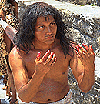 For the Maya, blood sacrifice was necessary for the survival of both gods and people, sending human energy skyward and receiving divine power in return. A king used an obsidian knife or a stingray spine to cut his penis, allowing the blood to fall onto paper held in a bowl. Kings' wives also took part in this ritual by pulling a rope with thorns attached through their tongues. The blood-stained paper was burned, the rising smoke directly communicating with the Sky World.
For the Maya, blood sacrifice was necessary for the survival of both gods and people, sending human energy skyward and receiving divine power in return. A king used an obsidian knife or a stingray spine to cut his penis, allowing the blood to fall onto paper held in a bowl. Kings' wives also took part in this ritual by pulling a rope with thorns attached through their tongues. The blood-stained paper was burned, the rising smoke directly communicating with the Sky World.
Human sacrifice was perpetrated on prisoners, slaves, and particularly children, with orphans and illegitimate children specially purchased for the occasion. Before the Toltec era, however, animal sacrifice may have been far more common than human - turkeys, dogs, squirrels, quail and iguana being among the species considered suitable offerings to Maya gods.
 The shaman is about to perform a cha-chac ceremony: a petition to the god, Chac, to send rain.
The shaman is about to perform a cha-chac ceremony: a petition to the god, Chac, to send rain.
Priests were assisted in human sacrifices by four older men who were known as chacs, in honour of the Rain God, Chac. These men would hold the arms and legs of a sacrificial victim while the chest was opened up by another individual called a nacom. Also in attendance was the chilam, a shaman figure who received messages from the gods while in a trance, and whose prophecies were interpreted by the assembled priests.
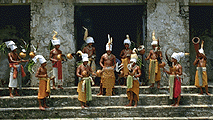 Public performances of ritual dancing and dramas, in which kings and nobles were transformed into gods by entering a visionary trance, were another means of communication with the spirit world. Marked by singing, the playing of musical instruments, and the shouts and jeers of thousands who came to witness the event, these rituals reaffirmed the king's power to act as a vessel in bringing supernatural powers into his domain for the benefit of his people.
Public performances of ritual dancing and dramas, in which kings and nobles were transformed into gods by entering a visionary trance, were another means of communication with the spirit world. Marked by singing, the playing of musical instruments, and the shouts and jeers of thousands who came to witness the event, these rituals reaffirmed the king's power to act as a vessel in bringing supernatural powers into his domain for the benefit of his people.
 This tiny figurine shows a ball player. The ball game is symbolic of the life-and-death battle that took place during the third creation. The floor of the court represented the earth's platform, which separates the human world from the Underworld. It was the gods who determined the winners of the ball game, just as they decided who would be victorious at war.
This tiny figurine shows a ball player. The ball game is symbolic of the life-and-death battle that took place during the third creation. The floor of the court represented the earth's platform, which separates the human world from the Underworld. It was the gods who determined the winners of the ball game, just as they decided who would be victorious at war.
The Maya believed that when people died, they entered the Underworld through a cave or a cenote. When kings died, they followed the path linked to the cosmic movement of the sun and fell into the Underworld; but, because they possessed supernatural powers, they were reborn into the Sky World and became gods. Death from natural causes was universally dreaded among the Maya, particularly because the dead did not automatically go to paradise. Ordinary people were buried beneath the floors of their houses, theirmouths filled with food and a jade bead, accompanied by religious articles and objects they had used when alive. The graves of priests contained books.
Great nobles were cremated - a practice of Mexican origin - and funerary temples were placed above their urns. In earlier days, nobles had been buried in sepulchres beneath mausoleums. Some Maya even mummified the heads of dead lords. These were then kept in family oratories and "fed" at regular intervals.
Following the Spanish conquest, there was a great deal of overlap between Maya and Christian belief systems. Some archaeologists have suggested that the systems were similar in many respects: both burned incense during rituals; both worshipped images; both had priests; both conducted elaborate pilgrimages based on a ritual calendar.
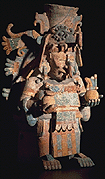
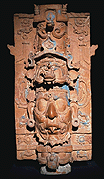 Two ceramic censers, used for burning incense at Maya religious ceremonies. That on the left represents the god Chac, holding a human heart in his left hand and a drinking cup in his right.
Two ceramic censers, used for burning incense at Maya religious ceremonies. That on the left represents the god Chac, holding a human heart in his left hand and a drinking cup in his right.
Most Maya today observe a religion composed of ancient Maya ideas, animism and Catholicism. Some Maya still believe, for example, that their village is the ceremonial centre of a world supported at its four corners by gods. When one of these gods shifts his burden, they believe, it causes an earthquake. The sky above them is the domain of the Sun, the Moon and the stars; however, the Sun is clearly associated with God the Father or Jesus Christ. The Moon is associated with the Virgin Mary.
Many Maya are convinced that the mountains which surround them are analogous to the ancient temple-pyramids. Mountains and hills are also thought to be the homes of ancestral deities: elderly father and mother figures who are honoured in the home with prayers and offerings of incense, black chickens, candles and liquor. In many Maya villages, traditional shamans continue to pray for the souls of the sick at mountain shrines. The Maya also believe in an Earth Lord - a fat, greedy half-breed who lives in caves and cenotes, controls all waterholes, and produces lightning and rain.
There is also a supernatural belief in the spirits of the forest. Some villages today have four pairs of crosses and four jaguar spirits or balam at the village's four entrances, in order to keep evil away. In agricultural rites, deities of the forest are still invoked, and it is still believed that evil winds loose in the world cause disease and sickness.
 The Maya Civilisation
The Maya Civilisation